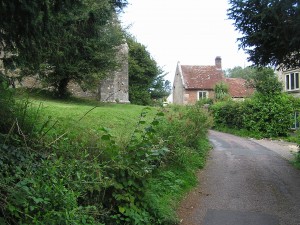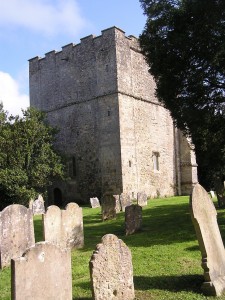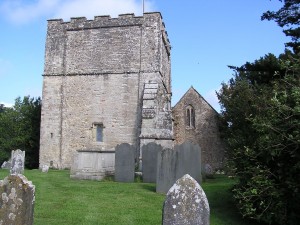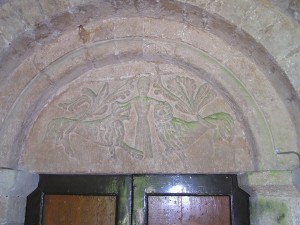The Tower of Shalfleet Church is the oldest on the Isle of Wight, and the most remarkable. Were there not a church attached to it, one would assume it was a defensive keep. The walls of this massive structure are over five feet thick, and there was originally no means of access from ground level: one had to climb an external ladder and scramble over the parapet. It is a structure that takes one’s breath away and has been described as ‘practically unique’. (Percy Stone, The Architectural Antiquities of the Isle of Wight, II, London 1891, pp.51-2.)

The Old Vicarage, Shalfleet: was it the site of the Saxon church? The Norman foundation is on the left.
The Tower was built in the later eleventh century, probably between 1070 and 1085, and may have been positioned at a distance from the Saxon church, the cemetery for which was in the garden of the Old Vicarage. (Ruth Waller, Archaeological Excavations in Shalfleet (Shalfleet, 2008.)
William fitz Osbern, the Conqueror’s cousin and close friend, to whom he had granted the lordship of the Island, had presented the manor of Shalfleet to Gozelin fitz Azur, his own subordinate knight who had probably fought beside him at Hastings, while the church was part of his endowment to the Abbey of Lyre in Normandy. The Tower that they quickly raised would not have been free-standing for long, for it was soon connected to a new church on the present site, with an arch giving access to the Tower from the nave. Apart from the Tower, their North Door has survived the subsequent alterations to the building, with its ‘quaintly carved tympanum … an ordinary Romanesque enrichment’. The best guess is that the curious scene of a man with two lions represents Daniel in the Lions’ Den.
 It has been suggested that a tower of such strength was intended as a refuge, for Shalfleet, with its flat shore, was particularly vulnerable to raiders from France (Stone, II, p.52; Brian Mead, The Church of St Michael the Archangel, Shalfleet, 2004). However, what Frenchman in the 1070s would have dared to invade the newly-annexed territory of William the Conqueror, given that he was the ‘strong man’ of northern France and notoriously swift in his retribution? Moreover, how would the frail and elderly have been expected to scramble up the Tower in times of danger? Although it undoubtedly served later as a defence against the French (and was equipped with its own three-pounder gun until 1779), it seems to me most unlikely that that was its original purpose.
It has been suggested that a tower of such strength was intended as a refuge, for Shalfleet, with its flat shore, was particularly vulnerable to raiders from France (Stone, II, p.52; Brian Mead, The Church of St Michael the Archangel, Shalfleet, 2004). However, what Frenchman in the 1070s would have dared to invade the newly-annexed territory of William the Conqueror, given that he was the ‘strong man’ of northern France and notoriously swift in his retribution? Moreover, how would the frail and elderly have been expected to scramble up the Tower in times of danger? Although it undoubtedly served later as a defence against the French (and was equipped with its own three-pounder gun until 1779), it seems to me most unlikely that that was its original purpose.
Was it not, rather, an outpost of the lordly control that was now being exercised from Carisbrooke Castle? Conspicuously more solid and expensive than the usual motte and bailey, a commission worthy of the Island’s central authority and ideally placed to hold sway over the West Wight, might it have been intended not to shelter the local populace, but to cow them into submission?

